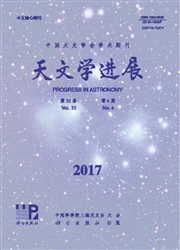

 中文摘要:
中文摘要:
罗西X射线时变探测器(RXTE)在中子星小质量X射线双星中发现了千赫兹准周期振荡现象(kHzQPO)。kHzQPO的频率一般在几百到上千赫兹,其动力学时标与吸积盘最内部区域物质的运动时标一致,因此普遍认为kHzQPO产生于中子星表面附近区域,携带了来自中心中子星及周围强引力场信息,如质量、自转周期、角动量、半径、磁场等。kHzQPO现象的理解为研究强引力场和致密物质状态开启了一扇新的窗口。着重介绍基于kHzQPO的基本现象和相应的理论模型。
 英文摘要:
英文摘要:
In the power density spectrum of neutron star in low mass X-ray binaries (LMXBs), the Rossi X-ray Timing Exploer (RXTE) detected kilohertz quasi-periodic oscillations (kHz QPOs). The frequencies of kHz QPOs range from a few hundreds to thousand, which corresponds to the dynamical time-scale for accreting matter in the inner part of the accretion disk. Therefore, it is generally thought to be occurred in the accretion flow close to the neutron star surface, which brings the information from the central compact star and its strong gravitational field, such as mass, spin period, angular momentum, radius, magnetic field, and so on. So, the kHz QPOs of accreting com- pact objects open up a new window on the physics of strong gravity and dense matter. Based on the basic phenomena of kHz QPOs, we primarily introduce the theoretical interpretations of kHz QPOs. There are two kinds of models for explain the kHz QPO theoretically. One is involved in the effects of magnetosphere, including the beat-frequency explanation and Alfvkn wave oscillation model. Both of them consider the interaction between the inner accretion disk and the magnetosphere. But the beat-frequency model predicts a constant frequency interval. With the increasing data, it is found that the frequency interval is variable. So this model is inapplicable. The other relates to the effects of strong field for general relativity, i.e. relativity precession model (RPM) and relativity resonant model (RRM). RPM takes the lense-Thirring precession and the classical precession caused by the gravitational quadrupole term due to the compact star rotating. RRM is a pure mathematical model and only can explain the the certain ratio frequency and some frequency relations. There are many physical problems which cannot be explained by this model, such as the detailed physics that gov- erns excitation, damping and modulation, the resonance modes and how to excite them, and so on. From the frequency relations among white dwarf, neutron star and black hol
 同期刊论文项目
同期刊论文项目
 同项目期刊论文
同项目期刊论文
 期刊信息
期刊信息
